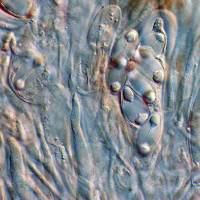
- Home
- Search
- Images
- Species Checklists
- US States: O-Z >
- US National Parks
- Central America
- South America
- US National Parks
- Southern Subpolar Region
|
|
|
|
Family: Teloschistaceae
[Phaeoplaca tortuca Søchting & Bungartz] |
MB#836952 Diagnosis. A corticolous species, distinguished from the morphologically extremely similar Phaeoplaca camptidia by its different ITS sequence. Type. Ecuador, Galápagos: Pinzón, along the trail going up from Playa Escondida, 0°36′10″S, 90°40′1″W, 254 m alt., dry zone, vegetation with Prosopis juliflora, Alternanthera filifolia, Maytenus octogona, and Croton scouleri, on wood, 16-Feb-2006, Bungartz, F. 3644 (CDS 27462‒holotype GenBank Accession number nrITS: MT967435). Description. Thallus an irregular, thin, waxy, continuous to rimose crust, often partially embedded in the substrate, effuse, but typically delimited by an indistinct or conspicuous black prothallus; surface pale creamy white to beige, smooth, not shiny, epruinose, lacking vegetative Chemistry. Thallus and apothecia P–, K–, C–, KC–, UV– (dull); no extractable secondary metabolites detected. Etymology. The epithet is intended as a noun in apposition to the genus name; it refers to the giant tortoises that inhabit the Galapagos archipelago. The name ‘tortuca’ itself is derived from a medieval poem about tortoises by Jacob van Maerlant in "Der naturen bloeme", acclaimed as one of the first encyclopedic treatises of natural history in the Dutch language. We accordingly chose this name in honor of the Dutch lichenologist André Aptroot for his encyclopedic knowledge of lichens and his significant contribution to investigating Galapagos lichen species. Ecology and distribution. Known only from the Galapagos. Prior to its description as a new species, specimens abundantly found in Galapagos were previously considered to belong to Caloplaca camptidia (Weber 1986, Elix & McCarthy 1998). It frequently grows on decorticated wood, but also on bark of Bursera graveolens, Scalesia pedunculata and Piscidia carthagenensis, in exposed or ± sheltered habitats, moderately common in the dry and lower transition, rarely also in the humid zone. Notes. Phaeoplaca tortuca belongs into the siderites-group. The species was originally reported from the Galapagos by Weber (1986) as C. camptidia, based on several specimens identified by C. M. Wetmore (e.g., Pike, L.H. 2117, L-55205, COLO 255633). The two species are virtually indistinguishable and phylogenetically closely related, but according to their ITS and mrSSU sequences nevertheless well separated. |













